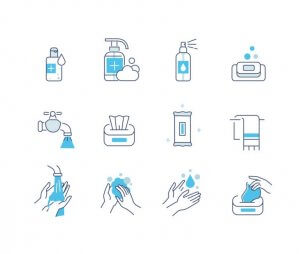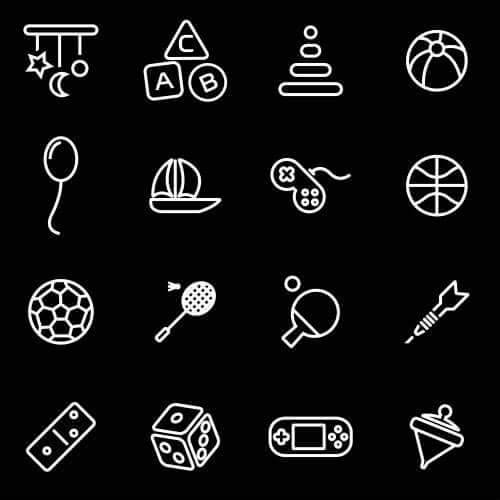What Are Visual Schedules with Pictograms?

Visual schedules with pictograms are very useful tools for children with autism spectrum disorder (ASD). Do you know how to use them? Below, we’ll explain what they are.
But, first of all, you should know that ASD is a neurodevelopmental disorder that mainly manifests with difficulties in two areas: communication and social interaction and thought flexibility and behavior.
In addition, in many cases, it can also cause significant language development alterations. Thus, it’s a great idea to use visual schedules with pictograms as a communication system.
What are visual schedules with pictograms?
A visual schedule with pictograms is a kind of notebook with space for certain images or illustrations that represent, in a simple and clear way, objects, people, actions, feelings, and situations, among other things.

These pictograms can be extracted from the Aragonese Portal of Augmentative and Alternative Communication (ARASAAC), which contains many graphic resources of this type. You can also use photos that children find familiar (photos of family members, teachers, and their personal belongings, among others).
The goal of this tool is to visually anticipate the activities the child will do at a particular time. This is perfect for many children with autism spectrum disorder (ASD), since, due to the mental rigidity that characterizes them, they usually require anticipation and planning to better understand what’s happening in their environment.
Thus, these visual schedules can be used in various contexts, such as:
- Home. To anticipate all the tasks that they need to do during their daily routine (shower, eat breakfast, brush their teeth, go to school, etc.).
- School. To anticipate all the activities they’ll do during the school day.
- Therapy. To anticipate what they’re going to do and the things they’ll work on in the therapy session.
How to use them
To correctly use visual schedules with pictograms, you have to follow these steps:
- Spend a few minutes using the schedule at the beginning of the day, the school day, or the therapy session, depending on the context it’s used in.
- As a parent, teacher, or therapist, choose, along with the child, the pictograms that represent the activities that they’ll do during the day, school day, or therapy session.
- Put the pictograms over the visual schedule.
- Read the pictograms aloud so that the child knows the order of the activities they’ll do.

This way, the child will structure the information in their mind and they may be sure of what’s going to happen at any given moment. This is very positive for children with ASD, as it allows them to have peace of mind and function well.
Other uses of visual schedules with pictograms
You can use visual schedules with pictograms for other purposes, such as to:
- Write down the date and weather.
- Represent important events that occur on that day (a birthday or holiday, for example).
- Allow the child to transmit and express their emotions and feelings at a certain time of the day.
- Anticipate what they’re going to do during the entire week.
- Anticipate the meals they’re going to have that day, as well as the time they’re going to have them or snacks.
- Represent the school supplies that the child must keep in their backpack, according to the subjects they’re going to have that day.
Visual schedules with pictograms are very useful tools for children with autism spectrum disorder (ASD). Do you know how to use them? Below, we’ll explain what they are.
But, first of all, you should know that ASD is a neurodevelopmental disorder that mainly manifests with difficulties in two areas: communication and social interaction and thought flexibility and behavior.
In addition, in many cases, it can also cause significant language development alterations. Thus, it’s a great idea to use visual schedules with pictograms as a communication system.
What are visual schedules with pictograms?
A visual schedule with pictograms is a kind of notebook with space for certain images or illustrations that represent, in a simple and clear way, objects, people, actions, feelings, and situations, among other things.

These pictograms can be extracted from the Aragonese Portal of Augmentative and Alternative Communication (ARASAAC), which contains many graphic resources of this type. You can also use photos that children find familiar (photos of family members, teachers, and their personal belongings, among others).
The goal of this tool is to visually anticipate the activities the child will do at a particular time. This is perfect for many children with autism spectrum disorder (ASD), since, due to the mental rigidity that characterizes them, they usually require anticipation and planning to better understand what’s happening in their environment.
Thus, these visual schedules can be used in various contexts, such as:
- Home. To anticipate all the tasks that they need to do during their daily routine (shower, eat breakfast, brush their teeth, go to school, etc.).
- School. To anticipate all the activities they’ll do during the school day.
- Therapy. To anticipate what they’re going to do and the things they’ll work on in the therapy session.
How to use them
To correctly use visual schedules with pictograms, you have to follow these steps:
- Spend a few minutes using the schedule at the beginning of the day, the school day, or the therapy session, depending on the context it’s used in.
- As a parent, teacher, or therapist, choose, along with the child, the pictograms that represent the activities that they’ll do during the day, school day, or therapy session.
- Put the pictograms over the visual schedule.
- Read the pictograms aloud so that the child knows the order of the activities they’ll do.

This way, the child will structure the information in their mind and they may be sure of what’s going to happen at any given moment. This is very positive for children with ASD, as it allows them to have peace of mind and function well.
Other uses of visual schedules with pictograms
You can use visual schedules with pictograms for other purposes, such as to:
- Write down the date and weather.
- Represent important events that occur on that day (a birthday or holiday, for example).
- Allow the child to transmit and express their emotions and feelings at a certain time of the day.
- Anticipate what they’re going to do during the entire week.
- Anticipate the meals they’re going to have that day, as well as the time they’re going to have them or snacks.
- Represent the school supplies that the child must keep in their backpack, according to the subjects they’re going to have that day.
This text is provided for informational purposes only and does not replace consultation with a professional. If in doubt, consult your specialist.








